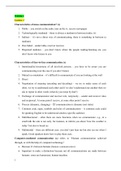WEEK 1
Lecture 1
Characteristics of mass communication? (x)
1. Public – you switch on the radio, turn on the tv, receive newspaper
2. Technologically mediated – there is always a medium in between (radio, tv)
3. Indirect – it’s not a direct way of communicating, there is something in between (a
medium)
4. One-Sided – sender talks, receiver receives
5. Dispersed audience – you don’t know where the people reading/listening are, you
don’t know who listens to you
Characteristics of face-to-face communication (x)
1. Intentionality/Awareness of all involved persons – you have to be aware you are
communicating (not the case if you don’t listen)
2. Mutual co-orientation – it’s difficult to communicate if you are looking at the wall
3. Direct
4. Negotiation of meaning (encoding and decoding) – we try to make sense of each
other, we try to understand each other and if we don’t understand one another then we
ask to repeat in other words (what do you mean by that?)
5. Exchange of communicator and receiver role, reciprocity – sender and receiver roles
and reciprocal. At some point I receive, at some other point I receive
6. Process (dynamic, changing) – f2f communication is dynamic (not static)
7. Common code, signs, symbols and rules of communication – A common code could
be speaking English to be understood amidst a specific audience
8. Multifunctional – often there are more functions when we communicate: e.g., in a
small talk the aim is not only, for instance, to inform you about ‘how the weather is
today’ but also to break ice
9. Multimodal – there are different cues: you don’t just hear me but also see me when I
speak. Good speakers know how to play these cues.
Computer-mediated communication (x) refers to “Human communication achieved
through, or with the help of, computer technology”
* Because it’s between humans (human communication)
* Important to make a distinction because not all communications are made between
humans: some are human-pet, human-machine
1
,Different dimensions of computer-mediated communication (x)
1. Mode (text, audio, visual) – once it was only texting but then, for instance, emojis
were introduced to help make sense of a conversation (sometimes it’s hard to
understand you are trying to make a joke, but a laughing emoji can help)
2. Synchronous vs. Asynchronous – immediate conversations (e.g., f2f) versus
asynchronous (e.g., emails)
3. Public vs Non-public – what should be public what should it not? We are now much
more aware of what should and what shouldn’t
4. Dyadic vs. Group – two-people conversation or WhatsApp group?
5. Anonymous vs Nonymous – you can decide whether to provide your true name or not
6. Professional/Work-related vs. Private
Technology (x) can be defined as “A manner of accomplishing a task especially using
technical processes, methods or knowledge”
* Very broad definition
* Paper can also be a technology according to this definition
Emerging technologies (x)
1. Radical novelty – e.g., smartphones have changed our life drastically
2. Relatively fast growth – smartphones became really critical taking over lots of tasks
(which now can be done via smartphones)
3. Coherence – One coherent technology where social aspects are also included (social
media – technology based on social cues)
4. Potential to have prominent impact on socio-economic domains
5. Uncertainty and ambiguity in the emergence phase – privacy? fake news? We
wouldn’t have these things if the internet didn’t exist
Crucial technological changes (x)
1. Exponential increases in computer power – think how computers were, and how they
are now
2. Mobile connectivity – we take it for granted now but before we only had ethernet
cables to connect computers to Wi-Fi
2
, 3. Datafication; networked information – nearly everything is turned into data: all what
we do is data, information
4. Miniaturization of sensors, microphones, and cameras – all became smaller: smaller
camera, smaller technologies (cheaper and more powerful)
5. Cloud computing – before we only hard hard-disks
6. Progress in artificial intelligence, machine learning – AI has been around for a decade
at least but what made the change is data. We now have enormous amount of data
available with which we now feed machine learning
The hype cycle of emerging technologies (x)
There are some technologies that go a little forgotten for a while and then take off all
of a sudden again
At the beginning some technologies hype, then slow down, and then stabilize at a
reasonable level
Characteristics of innovation (x)
Why do some inventions take off while some other don’t? How do we explain innovation?
Through these 5 characteristics we detect whether something is innovational or not:
1. Relative advantage – new technology has to be better to what there was before
3





